Behavior and Mechanism of a Novel Hydrophobic Collector in the Flotation of Bastnaesite
Abstract
:1. Introduction
2. Materials and Methods
2.1. Materials
2.2. Synthesis and Characterization of PHA
2.3. Experiments Methods
2.3.1. Flotation Experiments
2.3.2. Zeta Potential Measurements
2.3.3. FTIR Measurements
2.3.4. XPS Measurements
2.3.5. DFT Calculation
3. Results
3.1. Micro-Flotation Experiment Results
3.1.1. Single Mineral Flotation Test
3.1.2. Artificially Mixed Minerals Flotation Test
3.2. Zeta Potential Measurements Result
3.3. FTIR Measurements Result
3.4. XPS Measurement Results
3.5. DFT Results
4. Conclusions
Author Contributions
Funding
Acknowledgments
Conflicts of Interest
References
- Dushyantha, N.; Batapola, N.; Ilankoon, I.M.S.K.; Rohitha, S.; Premasiri, R.; Abeysinghe, B.; Ratnayake, N.; Dissanayake, K. The story of rare earth elements (REEs): Occurrences, global distribution, genesis, geology, mineralogy and global production. Ore Geol. Rev. 2020, 122, 103521. [Google Scholar] [CrossRef]
- Gupta, S.K.; Sudarshan, K.; Kadam, R.M. Optical nanomaterials with focus on rare earth doped oxide: A Review. Mater. Today Commun. 2021, 27, 102277. [Google Scholar] [CrossRef]
- Huang, G.; Lou, L.; Song, W.; Li, M.; Hou, F.; Li, X. Microstructure and magnetic properties of (SmCo+FeCo)/NdFeB multicomponent nanocomposite magnets fabricated by HPTC with change in heating temperature and composition. J. Rare Earths 2020, 38, 742. [Google Scholar] [CrossRef]
- Madavali, B.; Shin, D.W.; Song, S.H.; Kim, D.S.; Lee, J.K.; Hong, S.J. Preparation and thermoelectric performance of nano rare-earth oxides dispersed p-type BiSbTe alloys by mechanical milling and spark plasma sintering. Mater. Chem. Phys. 2020, 253, 123378. [Google Scholar] [CrossRef]
- Wang, L.; Yu, X.; Wei, Y.; Liu, J.; Zhao, Z. Research Advances of Rare Earth Catalysts for the Catalytic Purification of Vehicle Exhausts. J. Rare Earths 2021, 39, 1151–1180. [Google Scholar] [CrossRef]
- Wang, C.; Ma, R.; Zhou, Y.; Liu, Y.; Daniel, E.F.; Li, X.; Wang, P.; Dong, J.; Ke, W. Effects of rare earth modifying inclusions on the pitting corrosion of 13Cr4Ni martensitic stainless steel. J. Mater. Sci. Technol. 2021, 93, 232. [Google Scholar] [CrossRef]
- Sharma, V.K.; Kumar, V. Development of rare-earth oxides based hybrid AMCs reinforced with SiC/Al2O3: Mechanical & metallurgical characterization. J. Mater. Res. Technol. 2019, 8, 1971. [Google Scholar]
- Fan, X.; Ding, G.; Chen, K.; Guo, S.; You, C.; Chen, R.; Lee, D.; Yan, A. Whole process metallurgical behavior of the high-abundance rare-earth elements LRE (La, Ce and Y) and the magnetic performance of Nd0.75LRE0.25-Fe-B sintered magnets. Acta Mater. 2018, 154, 343. [Google Scholar] [CrossRef]
- Kumar, D.; Sharma, S.K.; Verma, S.; Sharma, V.; Kumar, V. A Short Review on Rare Earth Doped NaYF4 Upconverted Nanomaterials for Solar Cell Applications. Mater. Today Proc. 2020, 21, 1868. [Google Scholar] [CrossRef]
- Guo, Q.; Wu, J.; Yang, Y.; Liu, X.; Sun, W.; Wei, Y.; Lan, Z.; Lin, J.; Huang, M.; Chen, H.; et al. Low-temperature processed rare-earth doped brookite TiO2 scaffold for UV stable, hysteresis-free and high-performance perovskite solar cells. Nano Energy 2020, 77, 105183. [Google Scholar] [CrossRef]
- Chen, X.; Shi, Z.; Pan, G.; Zhu, J.; Hu, J.; Wu, Y.; Tian, Y.; Li, X.; Xu, W. Boosting interfacial charge transfer by constructing rare earth–doped WOx nanorods/SnO2 hybrid electron transport layer for efficient perovskite solar cells. Mater. Today Energy 2021, 21, 100724. [Google Scholar] [CrossRef]
- Kujur, M.S.; Deshpande, A.; Mallick, A.; Gupta, M. Development of rare-earth oxide reinforced magnesium nanocomposites targeting biomedical applications. Mater. Today Proc. 2020, 33, 5414. [Google Scholar] [CrossRef]
- Abaka-Wood, G.B.; Zanin, M.; Addai-Mensah, J.; Skinner, W. Recovery of rare earth elements minerals from iron oxide–silicate rich tailings—Part 1: Magnetic separation. Miner. Eng. 2019, 136, 50. [Google Scholar] [CrossRef]
- Zhang, S.; Huang, Z.; Wang, H.; Liu, R.; Cheng, C.; Guo, Z.; Fu, W. Separation of wolframite ore by froth flotation using a novel “crab” structure sebacoyl hydroxamic acid collector without Pb(NO3)2 activation. Powder Technol. 2021, 389, 96–103. [Google Scholar] [CrossRef]
- Wu, Y.; Song, M.; Zhang, Q.; Wang, W. Review of rare-earths recovery from polishing powder waste. Resour. Conserv. Recycl. 2021, 171, 105660. [Google Scholar] [CrossRef]
- Borra, C.R.; Mermans, J.; Blanpain, B.; Pontikes, Y.; Binnemans, K.; van Gerven, T. Selective recovery of rare earths from bauxite residue by combination of sulfation, roasting and leaching. Miner. Eng. 2016, 92, 151. [Google Scholar] [CrossRef]
- Zou, D.; Li, H.; Deng, Y.; Chen, J.; Bai, Y. Recovery of lanthanum and cerium from rare earth polishing powder wastes utilizing acid baking-water leaching-precipitation process. Sep. Purif. Technol. 2021, 261, 118244. [Google Scholar] [CrossRef]
- Marion, C.; Li, R.; Waters, K.E. A review of reagents applied to rare-earth mineral flotation. Adv. Colloid Interface Sci. 2020, 279, 102142. [Google Scholar] [CrossRef]
- Meng, D.; Wang, M.; Feng, Z.; Xia, C.; Zhao, Y.; Huang, X. Behavior of phase transformation of Baotou mixed rare earth concentrate during oxidation roasting. J. Rare Earths 2021, 40, 981–987. [Google Scholar] [CrossRef]
- Elizondo-Alvarez, M.A.; Uribe-Salas, A.; Bello-Teodoro, S. Chemical stability of xanthates, dithiophosphinates and hydroxamic acids in aqueous solutions and their environmental implications. Ecotoxicol. Environ. Saf. 2021, 207, 111509. [Google Scholar] [CrossRef]
- Shen, Y.; Nagaraj, D.R.; Farinato, R.; Somasundaran, P. Study of xanthate decomposition in aqueous solutions. Miner. Eng. 2016, 93, 10. [Google Scholar] [CrossRef] [Green Version]
- Espiritu ER, L.; da Silva, G.R.; Azizi, D.; Larachi, F.; Waters, K.E. Flotation behavior and electronic simulations of rare earth minerals in the presence of dolomite supernatant using sodium oleate collector. J. Rare Earths 2019, 37, 101. [Google Scholar] [CrossRef]
- Espiritu, E.R.L.; Naseri, S.; Waters, K.E. Surface chemistry and flotation behavior of dolomite, monazite and bastnäsite in the presence of benzohydroxamate, sodium oleate and phosphoric acid ester collectors. Colloids Surf. A Physicochem. Eng. Asp. 2018, 546, 254. [Google Scholar] [CrossRef]
- Duan, H.; Liu, W.; Wang, X.; Gu, X.; Sun, W.; Peng, X.; Yue, H. Investigation on flotation separation of bastnaesite from calcite and barite with a novel surfactant: Octylamino-bis-(butanohydroxamic acid). Sep. Purif. Technol. 2021, 256, 117792. [Google Scholar] [CrossRef]
- Abaka-Wood, G.B.; Zanin, M.; Addai-Mensah, J.; Skinner, W. The upgrading of rare earth oxides from iron-oxide silicate rich tailings: Flotation performance using sodium oleate and hydroxamic acid as collectors. Adv. Powder Technol. 2018, 29, 3163. [Google Scholar] [CrossRef]
- Deng, L.; Zhao, G.; Zhong, H.; Wang, S.; Liu, G. Investigation on the selectivity of N-((hydroxyamino)-alkyl) alkylamide surfactants for scheelite/calcite flotation separation. J. Ind. Eng. Chem. 2016, 33, 131. [Google Scholar] [CrossRef]
- Liu, M.; Li, H.; Jiang, T.; Liu, Q. Flotation of coarse and fine pyrochlore using octyl hydroxamic acid and sodium oleate. Miner. Eng. 2019, 132, 191. [Google Scholar] [CrossRef]
- Meng, Q.; Yuan, Z.; Li, L.; Lu, J.; Yang, J. Modification mechanism of lead ions and its response to wolframite flotation using salicylhydroxamic acid. Powder Technol. 2020, 366, 477–487. [Google Scholar] [CrossRef]
- Liu, X.; Li, C.; Luo, H.; Cheng, R.; Liu, F. Selective reverse flotation of apatite from dolomite in collophanite ore using saponified gutter oil fatty acid as a collector. Int. J. Miner. Processing 2017, 165, 20. [Google Scholar] [CrossRef]
- Zhang, B.; Zhong, H. Determination of hydroxamic acids by direct spectrophotometry of colored complex in acidic solution. Res. Chem. Intermed. 2010, 36, 495. [Google Scholar] [CrossRef]
- Guo, Z.; Khoso, S.A.; Wang, J.; Zhang, C.; Gao, Z.; Sun, W.; Tian, M.; Liu, Y. Interaction mechanism of 2-hydroxy-3-naphthyl hydroxamic acid and 1-hydroxy-2-naphthyl hydroxamic acid in the flotation separation of bastnaesite/fluorite: Experiments and first-principles calculations. Sep. Purif. Technol. 2022, 285, 120307. [Google Scholar] [CrossRef]
- Duan, H.; Huang, X.; Cao, X.; Cao, Z.; Zhong, H.; Zeng, J.; Zhou, H.; Xue, J.; Liu, Y. Investigating the flotation performance and interfacial adsorption mechanism of N-benzoyl-N’,N’-diethyl thiourea on chalcopyrite and pyrite. Miner. Eng. 2021, 172, 107178. [Google Scholar] [CrossRef]
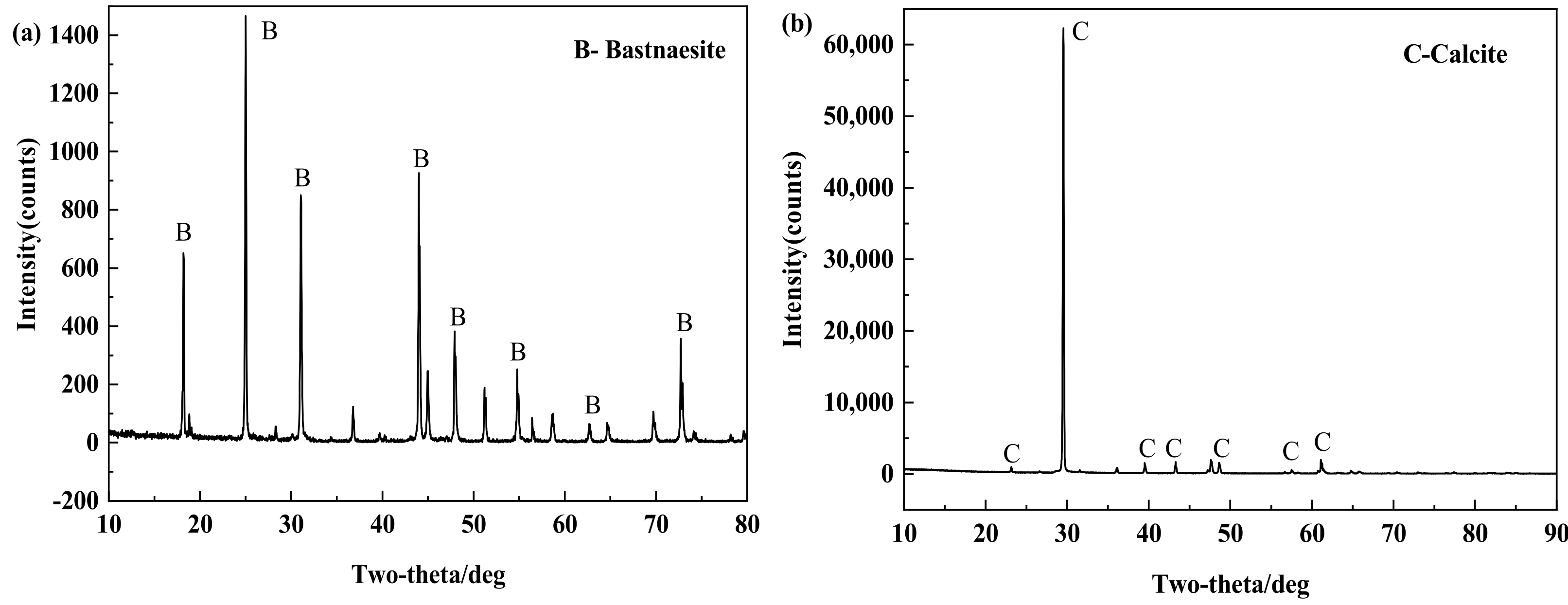

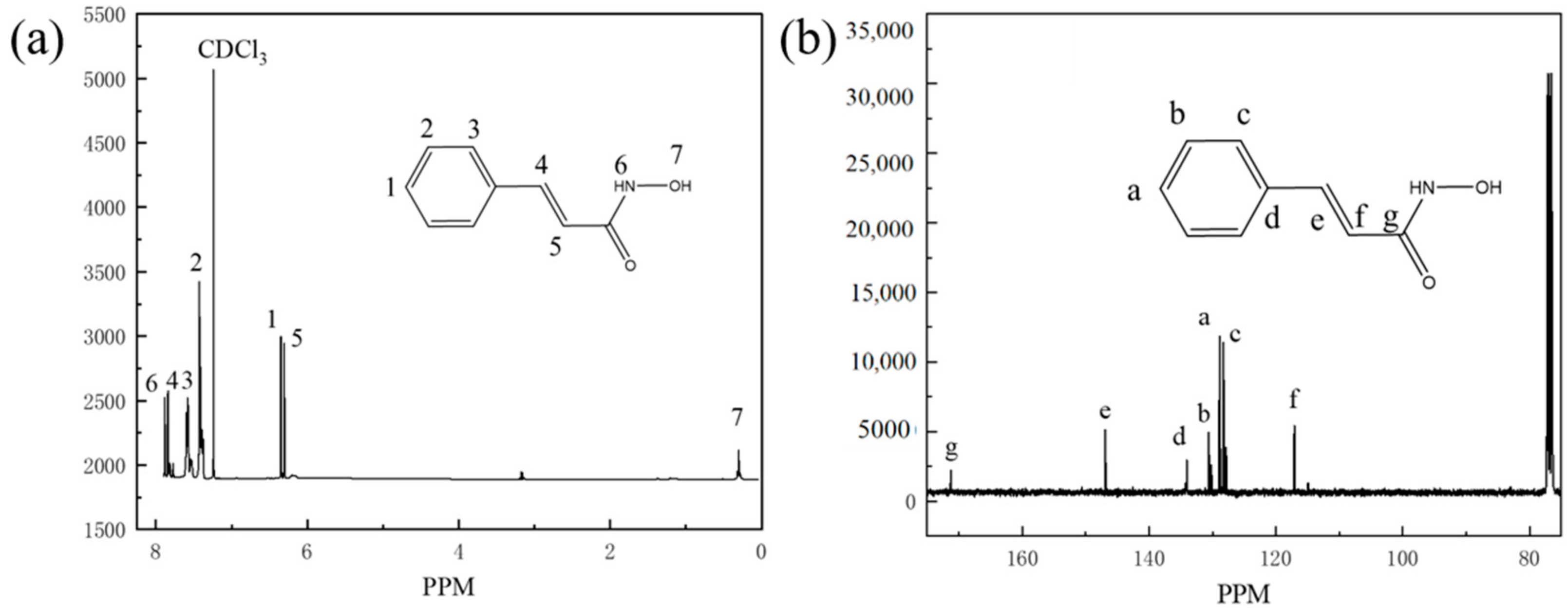
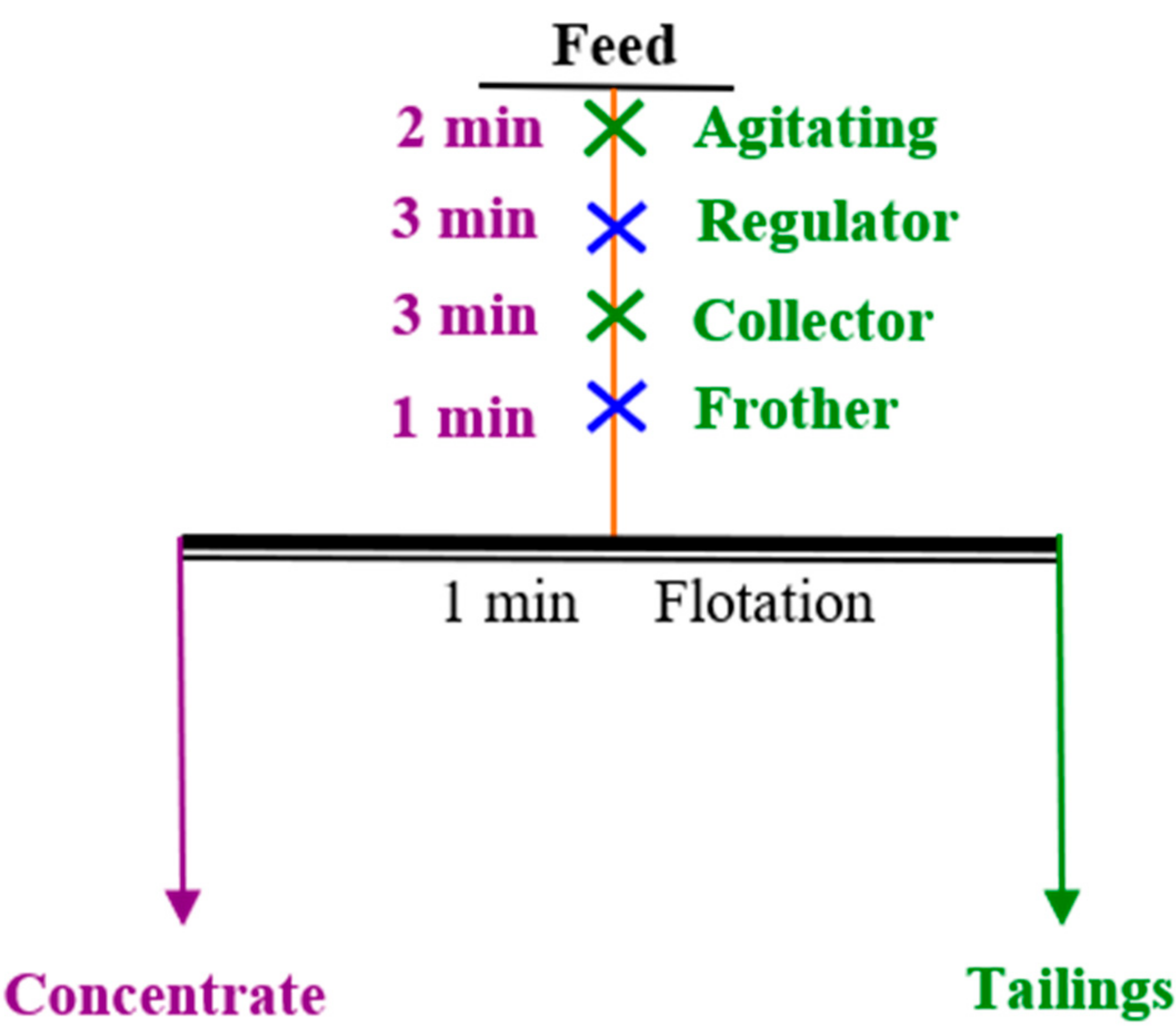
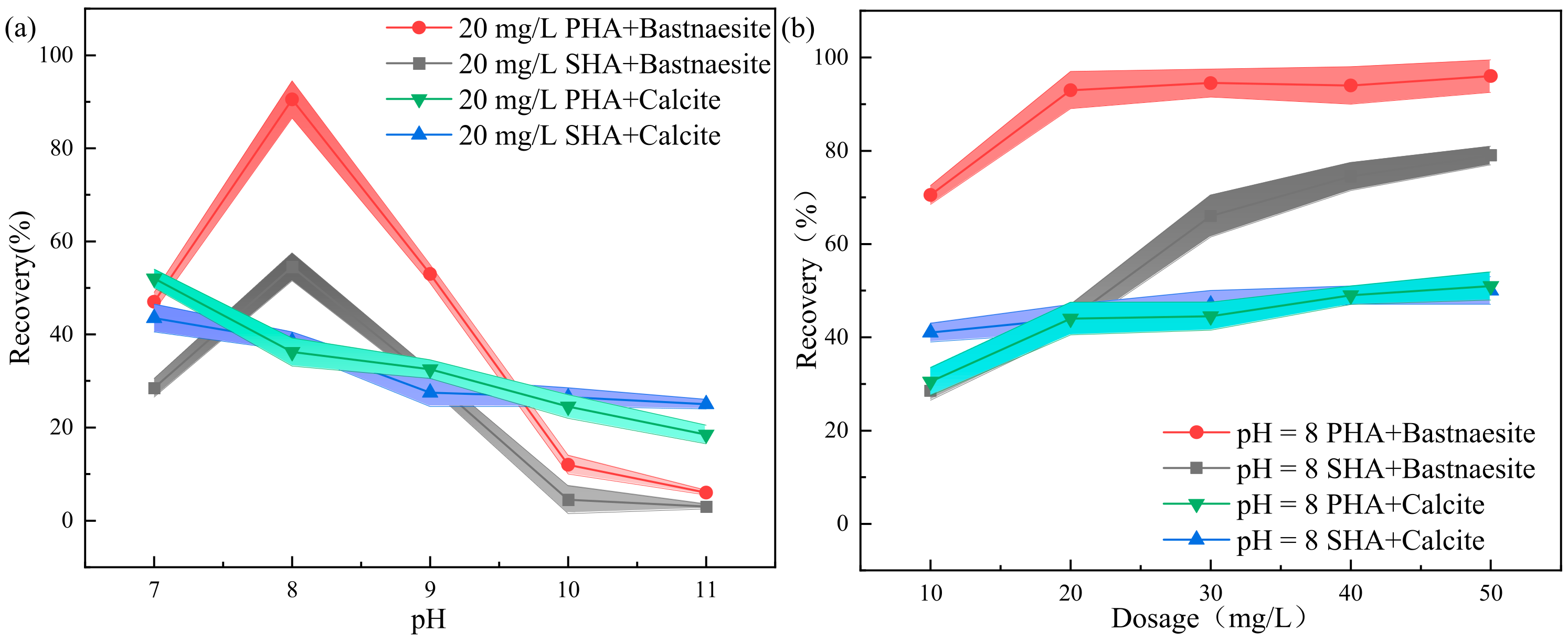
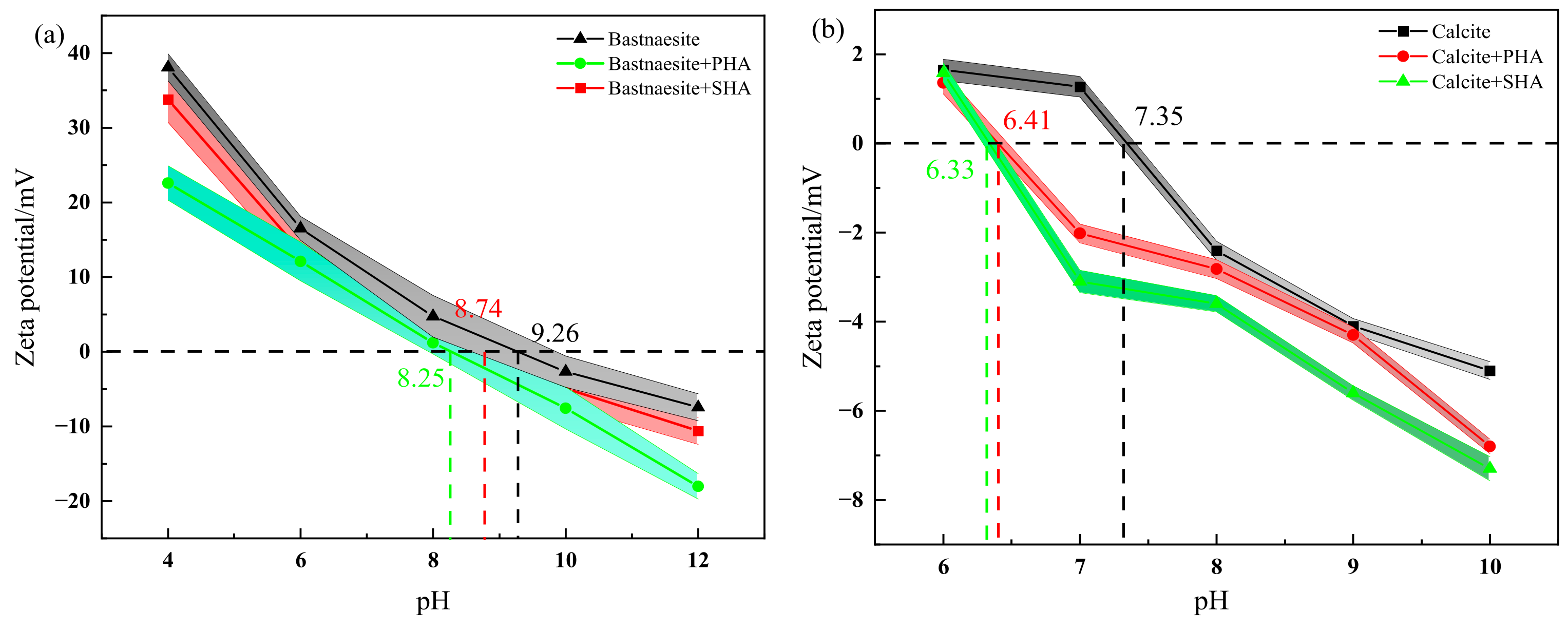
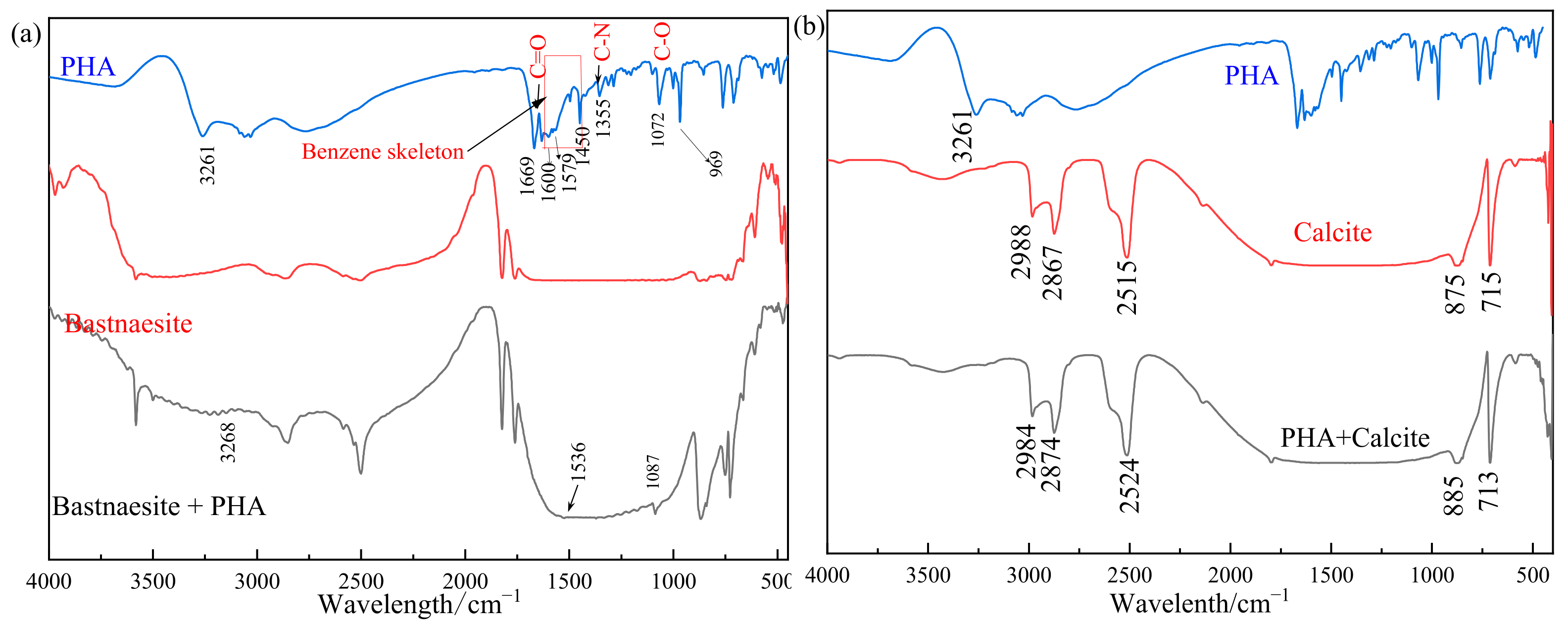
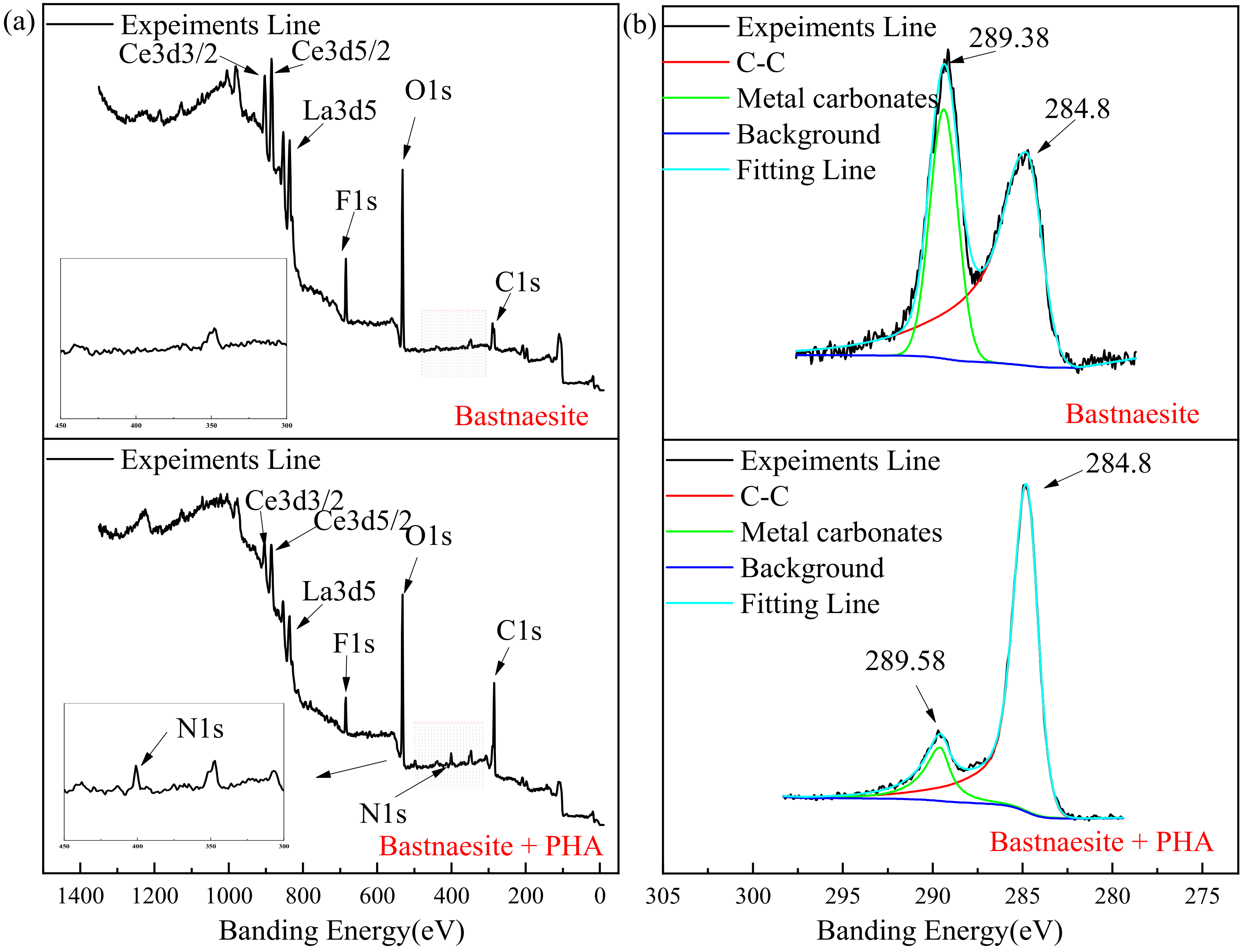

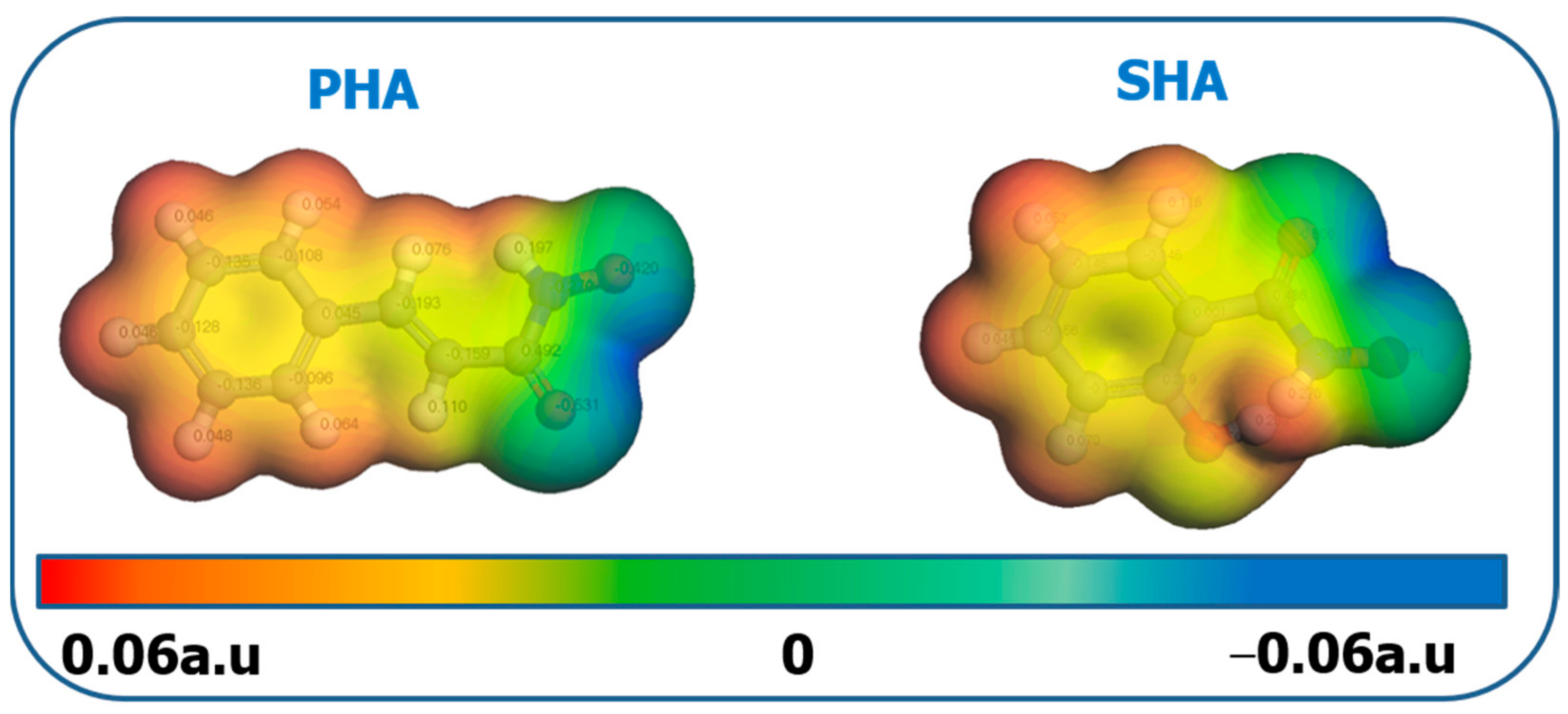
| Sample | REO | F | CaCO3 | SiO2 |
|---|---|---|---|---|
| Bastnaesite | 74.28 | 7.71 | 0.12 | 0.22 |
| Calcite | -- | -- | 98.82 | 0.42 |
| Flotation Conditions | Grade (%) | Recovery (wt %) | ||
|---|---|---|---|---|
| Bastnaesite | Calcite | Bastnaesite | Calcite | |
| pH = 8, PHA: 20 mg/L, humic acid sodium: 2 mg/L | 75.12 | 24.88 | 82.73 | 27.37 |
| pH = 8, SHA: 20 mg/L, humic acid sodium: 2 mg/L | 70.73 | 29.27 | 29.14 | 12.23 |
| Sample | C | N | O | Ce |
|---|---|---|---|---|
| Bastnaesite | 34.90 | 0 | 58.46 | 6.64 |
| Bastnaesite + PHA | 61.78 | 3.74 | 31.83 | 2.66 |
Publisher’s Note: MDPI stays neutral with regard to jurisdictional claims in published maps and institutional affiliations. |
© 2022 by the authors. Licensee MDPI, Basel, Switzerland. This article is an open access article distributed under the terms and conditions of the Creative Commons Attribution (CC BY) license (https://creativecommons.org/licenses/by/4.0/).
Share and Cite
Yao, X.; Yu, X.; Zeng, Y.; Mao, L.; Xie, H.; Liu, S.; He, G.; Huang, Z.; Wang, H.; Liu, Z. Behavior and Mechanism of a Novel Hydrophobic Collector in the Flotation of Bastnaesite. Minerals 2022, 12, 817. https://doi.org/10.3390/min12070817
Yao X, Yu X, Zeng Y, Mao L, Xie H, Liu S, He G, Huang Z, Wang H, Liu Z. Behavior and Mechanism of a Novel Hydrophobic Collector in the Flotation of Bastnaesite. Minerals. 2022; 12(7):817. https://doi.org/10.3390/min12070817
Chicago/Turabian StyleYao, Xiang, Xinyang Yu, Yuhui Zeng, Linghan Mao, Honghui Xie, Shanming Liu, Guichun He, Zhiqiang Huang, Haolin Wang, and Zhilin Liu. 2022. "Behavior and Mechanism of a Novel Hydrophobic Collector in the Flotation of Bastnaesite" Minerals 12, no. 7: 817. https://doi.org/10.3390/min12070817






